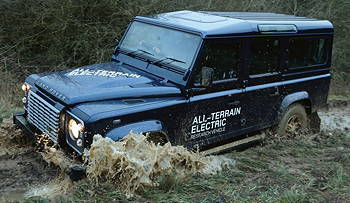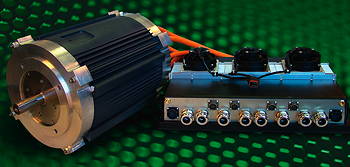Switched reluctance motors power electric Land Rovers

At the 2013 Geneva Motor Show, Land Rover unveiled a range of seven electric research vehicles powered by a switched reluctance (SR) motor and drive system developed in the UK.
The EVs are based on Land Rover's 110 Defender model in which the standard diesel engine and gearbox have been replaced by a 70kW switched reluctance motor, twinned with a 300V lithium-ion battery with a capacity of 27kWh, giving the vehicle a range of more than 80km on a full charge. The top speed is around 110km/h and, in typical low speed off-road use, the vehicles can run for up to eight hours before recharging.

The switched reluctance technology, developed and built by Harrogate-based Nidec SR Drives, is well suited to the Defender’s arduous all-terrain traction needs, being able to deliver full-rated power over a wide speed range. The electric vehicles (EVs) retain the Defender’s four-wheel drive system and differential lock. But, because the SR motor delivers 330Nm of torque from standstill, there’s no need for gear shifting and the transmission comprises a single-speed, 2.7:1 reduction gearbox, combined with the Defender’s standard four-wheel drive system.
For more than 30 years, SR Drives has been at the forefront of the development, application and commercialisation of switched reluctance technologies, and is widely regarded as the world leader in the field. In 2010, the Japanese motor-maker Nidec acquired the business from its previous owner, Emerson Electric.
Switched reluctance motors deliver high performance without needing rare-earth materials such as neodymium and dysprosium. The motors contain materials, such as copper, steel and aluminium that are recyclable at the end of their lives – an important consideration in automotive applications.

The smooth, low-speed capability of the SR electric powertrain makes the electric Defenders especially suitable for climbing and descending inclines without causing unnecessary damage to ground surfaces. The vehicles have been tested in extreme and environmentally sensitive conditions. The trials included pulling a 12-tonne “road train” up a 13% gradient, and wading through water up to 800mm deep. The absence of an air intake or exhaust system allows a 300mm increase in wading depth compared to standard Defenders.
“We are delighted to have worked with Land Rover on this exciting development”, says Nidec SR Drives’ managing director, Dr Roy Blake. “It was a great opportunity for us to transfer our proven traction technology from heavy-duty mining and construction vehicles to smaller road-going applications. The marriage of our rugged high-performance technology with the Defender vehicle is an excellent pairing and aligns well with plans by Nidec Corporation to place SR Drive technology at the heart of its EV traction developments.”
Nidec is currently developing magnet-free switched reluctance drive systems for electric vehicles, with the aim of launching them in around 2015.





